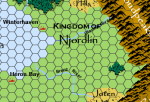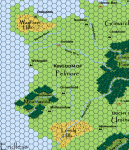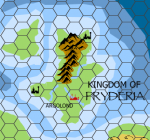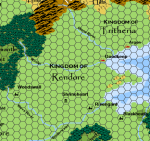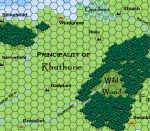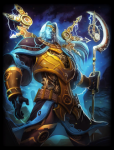Rhineglade
Adventurer
NAZAIRE
Official Name: Kingdom of Nazaire
Ruler: His Humble and Contrite Majesty, King Josune II of Nazaire, Prince of Calindrine (LN male human, Wiz 9)
Government: Independent constitutional monarchy with hereditary rulership; eldest male heir inherits throne or eldest female in the absence of a male heir; king has executive and judicial powers but most legislative powers lie within the House of Patricians, a law-making body composed of leading clerics, nobles and merchants
Coat of Arms:
Notable Figures: Queen Amaya of Nazaire (N female human, Rog 14); Princess Arantxa (LN female human, Wiz 6)
Rule of Law: Neutral. Moderate written laws exist with fair balance between the individual and the state; most laws however favor the wealthy class; application of the law varies from region to region
Population: 240,000
Capital: Calindrine (pop. 19,500)
Major Cities:
Major Religions: Kronum, Nerthys, Solovar, Eileania, Uino, Brannoc, Seralise
Major Resources: Wool, tin, fish, wine
Military: 9,000 (composed of equal parts heavy infantry and heavy cavalry; navy consists of 4 war galleys and 7 caravels)
Allies: Coronor, Floating Kingdoms, Pelinore (sometimes), Gwytheria (sometimes)
Enemies: Brimstone Isles, Viridia, Ursinore, Pelinore (sometimes)
The Kingdom of Nazaire is a minor kingdom located along the coastline south of Pelinore. It has had a long and turbulent past as neighboring rulers have often coveted the region both for its location and resources. Throughout its history, the region which would become Nazaire has evolved from tribal lands to minor kingdoms to fief territories and then into its present state as an independent monarchy. The Kings of Nazaire control the region from the Lone Hills to the Sea and as far east as the foothills of the Spineridge Mountains.
In its infancy, the kingdom was home to various Teleri and Comori tribal groups who generally fought over land rights. The dragonborn of the Brythonian Empire controlled the region for some time in the later days of the 4th Age into the early portion of the 5th. When the dragonborn eventually retreated to their ancestral lands, the Teleri Empire from the north conquered and subjugated these lands during the earlier part of the 5th Age.
By 823, the Lord of Calindrine, the most powerful of the local chieftains, united the other clans under one banner and expelled the Telerian Empire. Calindrine was declared a kingdom which eventually expanded in size changing its name to Nazaire in 1099. Sometime around the middle part of the 13th Century of the 5th Age, the kings of Nazaire had grown quite ineffectual and weak-minded. Collectively they became known as the Lazy Kings. The neighboring Duchy of Ursinore took advantage of this period and conquered roughly half of the kingdom which became the County of Nazaire under the suzerainty of the Ursinore dukes for roughly a century. In 1377, King Talos II of Nazaire, proved to be a shrewd and capable leader unlike his predecessors. The king led his forces against Ursinore and drove them back to their lands reclaiming the County and reuniting the nation under one lord once again. In order to accomplish this feat however, certain concessions had to be made with some of the wealthier merchant families. In exchange for the capital required to raise sufficient armies to repel Ursinore, the king had to grant seats on the Council of Patricians to several of the merchants thus giving them a voice in legislative matters.

Official Name: Kingdom of Nazaire
Ruler: His Humble and Contrite Majesty, King Josune II of Nazaire, Prince of Calindrine (LN male human, Wiz 9)
Government: Independent constitutional monarchy with hereditary rulership; eldest male heir inherits throne or eldest female in the absence of a male heir; king has executive and judicial powers but most legislative powers lie within the House of Patricians, a law-making body composed of leading clerics, nobles and merchants
Coat of Arms:
Notable Figures: Queen Amaya of Nazaire (N female human, Rog 14); Princess Arantxa (LN female human, Wiz 6)
Rule of Law: Neutral. Moderate written laws exist with fair balance between the individual and the state; most laws however favor the wealthy class; application of the law varies from region to region
Population: 240,000
Capital: Calindrine (pop. 19,500)
Major Cities:
Major Religions: Kronum, Nerthys, Solovar, Eileania, Uino, Brannoc, Seralise
Major Resources: Wool, tin, fish, wine
Military: 9,000 (composed of equal parts heavy infantry and heavy cavalry; navy consists of 4 war galleys and 7 caravels)
Allies: Coronor, Floating Kingdoms, Pelinore (sometimes), Gwytheria (sometimes)
Enemies: Brimstone Isles, Viridia, Ursinore, Pelinore (sometimes)
The Kingdom of Nazaire is a minor kingdom located along the coastline south of Pelinore. It has had a long and turbulent past as neighboring rulers have often coveted the region both for its location and resources. Throughout its history, the region which would become Nazaire has evolved from tribal lands to minor kingdoms to fief territories and then into its present state as an independent monarchy. The Kings of Nazaire control the region from the Lone Hills to the Sea and as far east as the foothills of the Spineridge Mountains.
In its infancy, the kingdom was home to various Teleri and Comori tribal groups who generally fought over land rights. The dragonborn of the Brythonian Empire controlled the region for some time in the later days of the 4th Age into the early portion of the 5th. When the dragonborn eventually retreated to their ancestral lands, the Teleri Empire from the north conquered and subjugated these lands during the earlier part of the 5th Age.
By 823, the Lord of Calindrine, the most powerful of the local chieftains, united the other clans under one banner and expelled the Telerian Empire. Calindrine was declared a kingdom which eventually expanded in size changing its name to Nazaire in 1099. Sometime around the middle part of the 13th Century of the 5th Age, the kings of Nazaire had grown quite ineffectual and weak-minded. Collectively they became known as the Lazy Kings. The neighboring Duchy of Ursinore took advantage of this period and conquered roughly half of the kingdom which became the County of Nazaire under the suzerainty of the Ursinore dukes for roughly a century. In 1377, King Talos II of Nazaire, proved to be a shrewd and capable leader unlike his predecessors. The king led his forces against Ursinore and drove them back to their lands reclaiming the County and reuniting the nation under one lord once again. In order to accomplish this feat however, certain concessions had to be made with some of the wealthier merchant families. In exchange for the capital required to raise sufficient armies to repel Ursinore, the king had to grant seats on the Council of Patricians to several of the merchants thus giving them a voice in legislative matters.

Last edited:


